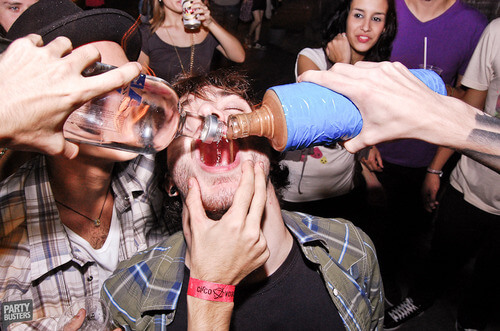USA Today recently reported on a study “College Party Culture & Sexual Assault” where it highlighted the increase in drunkenness on college football days. The study showed that DUIs and sexual assaults increase on days that there is a football game. It’s obvious that the consequences of alcohol abuse and binge drinking reach much further than addiction or alcoholism. Our culture with alcohol has become acceptable, especially among young people. It’s expected that we get wasted, it’s not a good party if you don’t get drunk. Getting wasted doesn’t equal a good time, often it can end up being the worst time of your life. Sporting events should be about physical activity, team playing, hard work, determination, healthy competition and sportsmanship not drinking as is currently the case. Our culture of alcohol abuse comes with a range of consequences from DUIs and sexual assault to road deaths, physical assault and murder. Addiction is hugely destructive and has lifelong consequences for addicts but alcohol abuse and binge drinking also destroys lives beyond repair.
The minimum drinking age is 21 in the US, however many young people across the country still consume alcohol. Young people are already vulnerable with less life experience than an adult and a lesser sense of responsibility, add alcohol to the equation and it is a recipe for disaster. Binging and alcohol abuse is categorized as five or more drinks in a row; for young people based on body mass and brain development this can have a much more significant effect than on an adult. Such abuse then obviously poses enormous health and safety risks, as well as negative implications for families and society. The issues that arise are common and things we are all far too familiar with; neighborhood disturbances, property damage, disorderly conduct, injuries, aggression, and violence. All of these issues have consequences and cost money; they are a drain on public services and resources with avoidable trips to accident and emergency, needless arrests and police call outs and overall negative to our society.

The severity of alcohol in terms of use and abuse is often underestimated when in fact it is the most used and abused drug in the United States. It is also the most associated with violent crimes such a rape, domestic abuse, assault and murder. Most violent crimes involve alcohol, with half of all assaults and homicides occurring when the perpetrator, victim or both have been intoxicated. Looking specifically at college students, 600,000 between the ages of 18 and 24 are assaulted by another student who has been drinking each year. On college campuses 95% of the violent crimes committed occur with the perpetrator, victim or both under the influence of alcohol and 90% of rapes and sexual assaults. Young lives are needlessly destroyed because of alcohol, with lowered inhibitions, compromized rationale and common sense diminished it changes the individual and makes people do and act in ways they would not in sobriety. Sadly the law is not sympathetic to how one usually behaves and it is no consolation to a victim. A crime is a crime and the reality is that if you chose to binge drink then you have to deal with the consequences. With regards sexual assault and rape we hear a lot about self control, considering alcohol is so often involved maybe we should start promoting self control regards alcohol consumption instead.
Because alcohol is a legal drug it is often viewed as acceptable to use and abuse among the underage population. Young people are even less likely to see the true risks and see alcohol as part of student life, being young and enjoying themselves. Yes it can help us in having a good time, and responsibly it’s perfectly safe and acceptable, but young people must recognize the potential dangers associated with alcohol abuse and realize that if they drink they have every chance of becoming a statistic. Sadly youth and a feeling of invincibility go hand in hand, making it difficult for young people to acknowledge the risks. It could be because of this that alcohol is documented as being a factor in the four most leading causes of death among people aged 10-24 years.
Four leading causes of death 10-24 year olds:
- motor-vehicle crashes
- unintentional injuries
- homicide
- suicide
If you are under 21 and drinking 5 or more units of alcohol at one time then you are at risk of the following:
- Poor achievement & school performance
- Relationship issues with friends, family or partner- arguments, aggression, isolation
- Legal problems- DUIs, arrests, court dates, imprisonment
- Physical problems- hangovers, illnesses caused as a result of alcohol use
- Sexual problems- unplanned pregnanacy, sexualy transmitted infections
- Physical and sexual assault
- Increased risk of accidents & injury- car crashes, burns, falls, drowning
- Memory problems
- Issues with normal brain development- with possible lifelong effects
- Alcohol poisoning
- Death from overdose
- Increased risk of suicide or homicide
As adults we have a responsibility to protect and educate our young people. Re-educating and raising awareness of the risks and challenging the damaging relationships we have with alcohol will help in changing the culture of alcohol abuse. We need to look at new ways to celebrate, does a happy occasion or event need to result in everyone being intoxicated. When we consider the consequences and just how easily a good night can change and get out of hand, surely it’s worth considering an alternative and a new way to have fun. It’s not about demonizing alcohol but recognizing the dangers and being open to safer way to enjoy ourselves. Alcohol is not the enemy but we must be conscious of what and how much we are drinking. Leaving yourself in a position where you are not in control of your actions may be something you are left to regret for the rest of your life.
All of us can play a part in addressing this national, public health issue from parents to government. Parents can highlight the effects and implications of binge drinking, re educate their children and ensure that they are informed. Talking to young people about alcohol from a preteen age can help in tackling the culture of alcohol abuse. Schools and colleges can promote the benefits of alcohol free events and bring about a move towards alcohol free campuses and sporting events. Nationally government can increase the cost of alcohol, clamp down on sales and introduce stricter punishments for those buying for the underage and those selling to the underage.
Sources:
http://college.usatoday.com/2016/01/22/study-sexual-assault-reports-jump-28-on-college-game-days/
